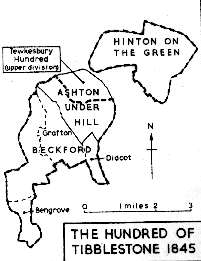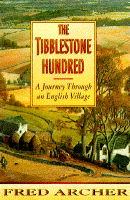The Tibblestone
HISTORY * MYSTERIOUS DISAPPEARANCE * SPELLINGS * LEGENDS
HOAX * TIBBLESTONE HUNDRED * BOOKS & REFERENCES * LINKS
The Tibblestone is a standing stone at the borders
of Gloucestershire and Worcestershire in England.
|
|
|
The Tibblestone is an ancient stone that stands by a crossroads in the Midlands of England. The grass is kept neatly cut by the Murco/Costcutter Garage of Teddington Hands, Gloucestershire who are well aware that the stone on their property is listed in the County's Sites and Monuments Record.
Its name means Stone of Tetbald. (A Tetbald was
tenant of the manor of Cliftone in Stoke Gifford Parish) It can also mean
Theobald's Stone, Theobald being a person recorded as a member of the
Northumbrian royal family.
The Stone Age
There are several known Stone Age sites in
Gloucestershire with probable connecting routes. One of these routes passes by
the Tibblestone. Similar stones in the county are believed to be the remains of
long barrows. Could the Tibblestone be one of these?
The Bronze Age
As the second millennium came to an end (1,000BC)
so did the building of round barrows. The burial of cremated remains in special
urns in small cemeteries became the common practice. Some of these cemeteries
were marked with standing stones and it has been suggested that some of the ones
in Gloucestershire, which were previously thought to be the remains of long
barrows, may have been used for this purpose. Could this have been an
alternative (or additional) function of the Tibblestone?
Years 450 - 1086 AD
The Tibblestone gave its name to the Tibblestone
Hundred (see below for full description of what a Hundred is.) Every village had
justice administered at a hundred court. These courts were attended by the
freedmen of the village at four weekly intervals, and were held in the open air.
The site of the Tibblestone was characteristic of the ancient sites of many
hundred courts as a choice of a prehistoric stone on neutral territory was quite
common.
Domesday Survey 1086
There is a reference to Tibaldstone in the
Domesday Survey.
Late 18th
Century
In 1779 the Tibblestone was a monolith recorded by Rudder as standing near the turnpike road from Tewkesbury, Gloucestershire, to London, England.
1987
It was listed on the 4th December 1987 as a Grade II building, ref 135270 with English Heritage, under Tewkesbury Borough Council. The Postcode is GL20 8JA.
Although old maps showed it, the stone went
"missing" and only came to light again in 1948 when workmen digging the
foundations of the former Esso Garage (now a Murco Garage) unearthed it.
Reported in the
Tewkesbury
Register & Gazette,
Saturday, April 17th 1948
"ANCIENT STONE UNEARTHED"
Its Curious Tradition
"When the Teddington Hands
Garage Ltd. decided to replant with grass at the front of their garage at the
junction of the Cheltenham-Evesham and Tewkesbury-Stow roads, they found what
they thought was a round stone, of which about a foot was showing, and dug to
raise it up. Although they had dug down for about eight feet by the weekend, the
stone, which is roughly cylindrical and about eighteen inches in diameter was
still not uncovered. They had found the Tibble Stone, marked on the six-inch
ordnance survey map, which is a boundary stone of which reference is made in the
Domesday Survey.
According to local folklore, a
giant at the back of Dixton Hill threw the stone towards the Severn at
Tewkesbury. His foot slipped and the mark is said to remain on the side of the
hill while the stone fell at Teddington Cross Hands.
Mr. D.W. Herdman (curator
Cheltenham Art Gallery and Museum) has examined the column and has kindly sent
to us the result of his researches.
In "Place-names of
Gloucestershire" by the last Dr. W. St. Clair Baddeley, appears the entry,
"Tiboldestone Hundred (Domesday Survey). It included Beckford. The Anglo-Saxon
personal name, Tetbald, Theodbeald: A.S. stan. Stone (i.e. boundary stone)
Tibaldstone and Cleeve form the modern Hundred."
Bryant's map of
Gloucestershire, published in 1824, confirms the theory that the stone was a
boundary mark, as it is at the boundary of the Tiboldstone Hundred.
The stone is deeply pitted
with holes, indicating that it may have borne projecting signs at an earlier
date. It is very roughly hewn and the geological formation is not yet
ascertained.
The garage company are anxious
that it should be dealt with sympathetically and Mr. Herdman has suggested that
it should be kept exactly in situ and raised, so that it might stand prominently
in the centre of what is to become a lawn in front of the garage.
The Ministry of Works have
been informed and will tell the garage company what is to be done with the
stone.
Several archaeologists have already been to Teddington Cross Hands."
The
stone was re-erected by the side of the Cheltenham road. About 30 years
ago the cross-roads were realigned and a roundabout was constructed, but the
stone remained to this present day.
Tibblestone Tibaldstone
Tedbaldston Tetboldstone
Tibboldstone
A
giant who lived on Dixton Hill a few miles away amused himself by hurling stones
at ships sailing on the River Severn, about seven miles away. Once,
he slipped as he threw, leaving a great scar on the hillside and landing his
missile off-target, at Teddington.
Another legend appears in Alfred Watkins book "
The Old Straight Track". A man motoring past Teddington Cross, east of
Tewkesbury, noticed a large, irregular stone where six roads meet. An old man at
the nearby inn (currently the Teddington Hands) told this tale about it.
" A long time ago, a giant lived in these parts, and he went up the hill to
fetch a large stone to destroy his enemy's house. When he was carrying it down,
his foot slipped, and his heel made a great furrow in the hillside, and you can
see it to this day, and he had to drop the stone just where you see it. It is
quite true because you can see for yourself the holes where the giant's fingers
had hold of it"
Reported in the
Gloucestershire Echo,
Friday, October 21, 1988
Prank left resident
stonefaced
A joke backfired on workmen
who told a resident that they were going to pull down an historic stone in a
Gloucestershire village.
The irate resident woke up
his councillor at 11 at night in a bid to stop the demolition - but it was all a
prank.
Engineers, who were working
on a new garage in Teddington Hands, were digging a trench next to the ancient
Tibblestone standing at the side of the road. When the resident asked them what
they were doing, they wound a rope around the five-foot column and said they
were going to pull it into the trench.
But embarrassed bosses
explained away the wind-up to Tewkesbury Borough Council officers who were
called in to investigate the complaints. Mr. Alan Martin, principal planning
officer, said; "it seems someone didn't share their sense of fun, and contacted
their councillor. Officers have been out there on other business and raised the
issue." There was no question of the Tibblestone being moved, said Mr. Martin.
The site is being developed
into a filling station and restaurant, and the Tibblestone, which is listed in
the county's Sites and Monuments Record, is nearby next to the road. Mr. Mike
Stacey, boss of the contractors on site, said, "We knew very well about this
Tibblestone. Road Chef have told us about it and we have known it was not to be
moved".
What is a Hundred? It is the name given to a portion of a county or shire for administration purposes. It is supposed to imply the territory occupied by a hundred families; or the space of a hundred hides of land, or the capacity of providing a hundred soldiers. Each hundred had its hundred court, but a County Court Act abolished this in 1867.
 |
The
Tibblestone hundred lay on the northern edge of the county, and in 1931
the greater part of the three parishes within it, Ashton under Hill,
Beckford and Hinton on the Green, was transferred to Worcestershire. The
land is partly on the southeast slopes of Bredon Hill, and partly on the
flat alluvial floor of the valley below. Whereas the hundred comprised
only a small area, 6,773 acres in all, from the 14th
century until the 20th, it was once much larger and
apparently stretched, in the 11th century or earlier, to the
river Severn and beyond. In 1086 the Tibblestone hundred included what
was later to become the hundred of Cleeve. The assessment of hides in
1086 suggests, in addition, that the hundreds of Tibblestone and
Deerhurst had a short while earlier formed together a double hundred of
200 hides. The suggestion is supported by later documents linking the
names of Deerhurst and Tibblestone hundreds in a way that suggests a
surviving tradition of their former unity. |
The
apparent abstraction from Tibblestone hundred of the Deerhurst hundred and of
parts of Stoke Orchard and of Ashton under Hill in the 11th century,
of Didcot in Beckford parish, and of Cleeve hundred in the 13th and
14th centuries, left only Hinton on the Green, most of Beckford, and
part of Ashton under Hill within the Tibblestone hundred. Whereas the part of
Beckford in the Tewkesbury hundred was small and distinct, Ashton under
Hill was divided evenly between the two hundreds; 24 yardlands were said c.
1590 to be in the Tibblestone hundred and 26 in the Tewkesbury hundred.
In the
Tibblestone parts of Ashton and Beckford, which formed a single manor, some
hundredal jurisdiction belonged to the lord of the manor who in the 13th
century had gallows and assize of bread and ale. The Abbot of Gloucester had the
same and also view of frankpledge at Hinton, which was represented by four men
and the reeve at the sheriff's tourn. By the 16th century the lord of
Beckford was also said to have view of frankpledge. In 1287 the hundred was in
the king's hands, and complaint was made that whereas there had formerly been
only one bailiff there were then four. No court rolls are known to survive the
Tibblestone hundred.
The
name of the hundred is connected with an ancient stone, the Tibblestone, on the
boundary of Beckford at the ancient road junction called Teddington Hands. That
was presumably the hundred meeting-place; though it is at the extreme southwest
end of the modern hundred, it is fairly central to the area, as argued above,
comprised the hundred until the 11th century. The Tibble Stone, which
was visible near the crossroads in the late 18th century, later
disappeared from sight and was re-erected in 1948.
"Folklore of Gloucestershire" by Roy Palmer (West
Country Books 1994)
"The Place Names of Gloucestershire" by A.H.Smith
Volume 2
Gloucestershire Place Names 1913
"The Old Straight Track" by Alfred Watkins
(Abacus1974)
"A History of Gloucestershire" pages 243, 244
"Gotherington" Towns & Villages of England, edited
by David H. Aldred
"The Tibblestone Hundred" by Fred Archer (Sutton Publishing 1996)

In Fred Archer's book, the history of the Tibblestone Hundred is traced, from its beginnings through the time when the Hundred Courts held sway in neighbour's disputes, up to his own era farming in the area, when the Hundred's successor in the Parish Council was all powerful. The book contains his reminiscences of country life on and around Bredon Hill like his previous 30 or so similar books.
|
|
"Old Stones of the Cotswolds & Forest of Dean" A survey of megaliths and mark stones past and present by D. P. Sullivan (Published by Reardon Publishing )
This new book is from Reardon Publishing called Old Stones of The Cotswolds. Not only is The Tibblestone on the front cover but inside there is a superb line drawing of it. The artist is Peter Reardon of Reardon Publishing. Should you wish to purchase your own copy you could visit the website www.reardon.co.uk |
|
Just opposite the Tibblestone is a public house The Teddington Hands formerly The Cross Hands) that covers the history of the roundabout where the roads meet.
*********************************************************
The Megalithic Portal contains a few photos, description and a Google Street View map.
**********************************************************
For an exceptionally good photograph of the Tibblestone, go to the site of Hans-Georg Stump. He is a German photographer who enjoys visiting the ancient sites of Britain and beyond.
***********************************************************
The Modern Antiquarian Web Site hosts eight pictures and recent field notes that visitors have made. The latest remarks come from Carl on 26th May 2010 who found the stone and gave it a gentle pat! It also gives us precise information here;
Nearest Town: Tewkesbury (7km WSW)
OS Ref (GB): SO963339 / Sheet: 150
Latitude: 52° 0' 10.95" N
Longitude: 2° 3' 14.06" W
**********************************************************
British History Online has a page on the Tibblestone hundred, detailing the break up of the hundred as described
in the 1968 book, A History of the County of Gloucester: volume 8 by C.R. Elrington
**********************************************************
The Heritage Journal has been maintained since March 2005 to promote awareness and the conservation of the incomparable but often-threatened prehistoric sites of Britain, Ireland and beyond. There is a great piece with fabulous photos about the Tibblestone written by Nigel Swift. The last paragraph says it all.
If you have enjoyed these pages or would like to get in touch about any of it please e-mail us.
or
sign the guestbook. Thank you!
You are visitor number
